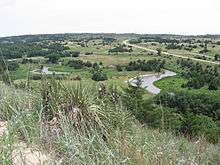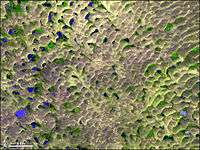Sandhills (Nebraska)
| Sandhills | |
| Region | |
| Sandhills in Hooker County, near sunset in October | |
| Country | |
|---|---|
| State | |
| Part of | Great Plains, High Plains |
| Rivers | Niobrara River, Snake River, North Loup River, Middle Loup River, Dismal River |
| Area | 19,600 sq mi (50,764 km2) |
 The Sandhills covers portions of northern and western Nebraska. | |
| Designated | 1984 |
The Sandhills, often written Sand Hills, is a region of mixed-grass prairie on grass-stabilized sand dunes in north-central Nebraska, covering just over one quarter of the state. The dunes were designated a National Natural Landmark in 1984.[1]
The sandhills are found in Arthur, Blaine, Brown, Cherry, Custer, Garden, Garfield, Grant, Holt, Hooker, Lincoln, Keith, Logan, Loup, McPherson, Morrill, Rock, Sheridan, Thomas, and Wheeler counties.[2]
Geography

The boundaries of the Sandhills are variously defined by different organizations. Depending on the definition, the region's area can be as small as 19,600 mi2 (50,760 km2)[3] or as large as 23,600 mi2 (61,100 km2).[4]
Dunes in the Sandhills may exceed 330 ft (100 m) in height. The average elevation of the region gradually increases from about 1,800 ft (550 m) in the east to about 3,600 ft (1,100 m) in the west.
The Sandhills sit atop the massive Ogallala Aquifer; thus both temporary and permanent shallow lakes are common in low-lying valleys between the grass-stabilized dunes prevalent in the Sandhills. The eastern and central sections of the region are drained by tributaries of the Loup River and the Niobrara River, while the western section is largely composed of small interior drainage basins.
The World Wide Fund for Nature (WWF) designated the Sandhills as an ecoregion, distinct from other grasslands of the Great Plains. According to their assessment, as much as 85% of the ecoregion is intact natural habitat, the highest level in the Great Plains. This is chiefly due to the lack of crop production: most of the Sandhills land has never been plowed.[4]
Paleoclimate and future
Paleoclimate proxy data and computer simulations reveal that the Nebraska Sandhills likely had active sand dunes as recently as the Medieval Warm Period, when temperatures in the North Atlantic region[5][6] were about 1°C (1.8°F) warmer than the current climate. Much of the area was a scrub desert, with desert-like conditions extending to several other states.[7][8] Current global warming may make the grassland climate more unstable, giving way to desert given more fires, mild drought and erosion; UCAR simulations based on evapotranspiration support a Palmer Drought Index lower than -15, many times more severe than Texas during the Dust Bowl.[9]

History
The plant-anchored dunes of the Sandhills were long considered an irreclaimable desert. In the 1870s, cattlemen began to discover their potential as rangeland for Longhorn cattle.
The fragility of the sandy soil makes the area unsuitable for cultivation of crops. Unsuccessful attempts at farming were made in the region in the late 1870s and again around 1890. Some development of cropland agriculture in the modern era has occurred through the use of center-pivot irrigation systems.
The 1904 Kinkaid Act allowed homesteaders to claim 640 acres (2.6 km2) of land, rather than the 160 acres (0.6 km2) allowed by the 1862 Homestead Act.[10] Nearly nine million acres (36,000 km2) were successfully claimed by "Kinkaiders" between 1910 and 1917. Some of the Kinkaiders attempted to farm, but these attempts generally failed. This included Nebraska's largest black settlement, DeWitty, which was located in southeast Cherry County until the 1930s. Many of the largest ranches broke up about the same time due to regulations against fencing federal range lands.
Today, the Sandhills are a productive cattle ranching area, supporting over 530,000 beef cattle. The population of the region continues to decline as older generations die out and as younger generations move to the cities. However, a number of small towns remain in the region.

Ecology
As the largest and most intricate wetland ecosystem in the United States, the Sandhills contain a large array of plant and animal life.[3] Minimal crop production has led to limited land fragmentation; the resulting extensive and continuous habitat for plant and animal species has largely preserved the biodiversity of the area.
The Sandhills are home to 314 vertebrate species including mule deer, white-tail deer, coyotes, red fox, meadowlarks, wild turkeys, badgers, skunks, native bat species and many fish species.
The Sandhills' thousands of ponds and lakes replenish the Ogallala Aquifer, which feeds creeks and rivers such as the Niobrara and Loup rivers. These bodies of water are homes for many species of fish. The lakes are mainly sandy-bottomed and provide water for the region's cattle, as well as a habitat for aquatic species. However, some lakes in the area are alkaline and support several species of phyllopod shrimp.
Plants
720 different species of plants are found in the Sandhills. Of these, the majority are native, with only 7% exotics — half the percentage of most other prairie systems. The blowout penstemon (Penstemon haydenii) is an endangered species, found only in the Sandhills and in similar environments in central Wyoming.[11] The blowout penstemon stabilizes the soil where wind erosion exposes the bare sand and creates a blowout, but is choked out when other species begin to recolonize. Grazing and land management practices used by Sandhills ranchers have reduced erosion, thus diminishing the plant's habitat.
Many of the plants of the Sandhills are sand-tolerant species from short-grass, mixed-grass and tallgrass prairies; plants from all three of these can be found within the ecosystem. These plants have helped to stabilize the sand dunes, creating an ecosystem beneficial for other plants and animals. Better land management and grazing practices by the ranchers of the region have led to less erosion over time, which has kept the natural landscape of the area mostly intact.
Insects
Many species of insect are found in the Sandhills, including dragonflies, grasshoppers and mosquitos. There are also many types of spiders. Due to the ephemeral nature of both alkaline and freshwater lakes throughout the region, coupled with the wetland marsh areas, mosquito populations increase during the summer months.
Birds
The Sandhills are part of the Central Flyway for many species of migratory birds, and the region's many bodies of water give them places to rest. The ponds and lakes of the region are lay-over points for migratory cranes, geese, and many species of ducks. Species found year-round include the western meadowlark, the state bird of Nebraska.
Climate
The Sandhills is classified as a semi-arid region, with average annual rainfall varying from 23 inches (580 mm) in the east to less than 17 inches (430 mm) of rain in the west. Temperatures range from lows of −30 °F (−34 °C) to highs of 105 °F (41 °C).
Conservation efforts and protection
Valentine National Wildlife Refuge, located about 20 miles (32 km) south of Valentine, covers 19,131 acres (77.42 km2). Crescent Lake National Wildlife Refuge in the central Panhandle covers 46,000 acres (175 km2). The Nature Conservancy's Niobrara Valley Preserve in Cherry, Brown, and Keya Paha counties covers 60,000 acres (202 km2) and includes a 25-mile (40 km) stretch of the river. Fort Niobrara National Wildlife Refuge near Valentine covers 19,000 acres (77 km2). Partnering in the effort to conserve the Sandhills are the Institute of Agriculture and Natural Resources, West Central Research and Extension Station, the Nature Conservancy of Nebraska, the Natural Resources Conservation Service, the Nebraska Natural Heritage Program, the University of Nebraska, and the United States Fish and Wildlife Service.
In a report (2011-11-10) on the Keystone Pipeline Project Presidential Permit Review Process, the U. S. State Department rejected TransCanada Keystone XL Pipeline (Hardisty-Baker-Steele City) proposal. "[G]iven the concentration of concerns regarding the environmental sensitivities of the current proposed route through the Sand Hills area of Nebraska, the Department has determined it needs to undertake an in-depth assessment of potential alternative routes in Nebraska [...] The comments were consistent with the information in the final Environmental Impact Statement (EIS) about the unique combination of characteristics in the Sand Hills (which includes a high concentration of wetlands of special concern, a sensitive ecosystem, and extensive areas of very shallow groundwater) and provided additional context and information about those characteristics. The concern about the proposed route’s impact on the Sand Hills of Nebraska has increased significantly over time, and has resulted in the Nebraska legislature convening a special session to consider the issue." [12]
See also
- Aeolian processes
- Barchan
- Blowout
- Desertification
- Dune
- Dust Bowl
- Sandhill
- List of ecoregions in the United States (WWF)
- Kinkaid Act
References
- ↑ "Nebraska Sand Hills". nps.gov. National Park Service.
- ↑ "Official site". Sandhills Task Force. Retrieved 23 December 2014.
- 1 2 U.S. Fish and Wildlife Service - Sandhills undated, URL retrieved on 21 July 2007
- 1 2 "Nebraska Sand Hills mixed grasslands (NA0809)". Terrestrial Ecoregions. World Wildlife Fund. Retrieved 21 July 2007.
- ↑ Folland, C.K.; Karl, T.R.; Christy, J.R.; Clarke, R.A.; Gruza, G.V.; Jouzel, J.; Mann, M.E.; Oerlemans, J.; Salinger, M.J. (2001). "2.3.3 Was there a "Little Ice Age" and a "Medieval Warm Period"?"". In Houghton, J.T.; Ding, Y.; Griggs, D.J.; Noguer, M.; van der Linden; Dai; Maskell; Johnson. Working Group I: The Scientific Basis. Intergovernmental Panel on Climate Change Climate Change 2001. Cambridge, United Kingdom and New York, NY, USA: Cambridge University Press. p. 881. ISBN 0-521-80767-0.
- ↑ Hughes, Malcolm K.; Diaz, Henry F. (1994). "Was there a 'medieval warm period', and if so, where and when?". Climatic Change. Kluwer Academic Publishers. 26 (2–3): 109–142. doi:10.1007/BF01092410.
- ↑ Mangan, Jennifer M.; Overpeck, Jonathan T.; Robert S., Webb; Wessman, Carol; Goetz, Alexander FH (2004). "Response of Nebraska Sand Hills natural vegetation to drought, fire, grazing, and plant functional type shifts as simulated by the CENTURY model". Climatic Change. 63 (1–2): 49–90. doi:10.1023/B:CLIM.0000018516.53419.90.
- ↑ Lynas, Mark (2008). Six Degrees: Our Future on a Hotter Planet. National Geographic. p. 336. ISBN 1-4262-0385-3.
- ↑ UCAR.edu (2011). "2060-2069". University Corporation for Atmospheric Research. Retrieved December 9, 2011.
- ↑ Nebraska State Historical Society, "U.S. Government Land Laws in Nebraska, 1854-1904" last updated 29 June 1998, URL retrieved on 21 July 2007
- ↑ "National Collection of Endangered Plants". US Center for Plant Conservation. Retrieved 2008-05-03.
- ↑ U.S.State Department (November 10, 2011). Media Notes on Keystone XL Pipeline Project Review Process: Decision to Seek Additional Information (Report). Washington, DC. Retrieved March 22, 2012.
Further reading
Bleed, Ann (1990). An Atlas of the Sand Hills. New York: Conservation and Survey Division, University of Nebraska at Lincoln. ISBN 1-56161-002-X.
Jones, Stephen (2000). The Last Prairie. Camden Maine: Ragged Mountain Press McGraw Hill. ISBN 0-07-135347-X.
External links
- World Wildlife Fund (2001). "Nebraska Sand Hills". WildWorld Ecoregion Profile. National Geographic Society. Archived from the original on 2010-03-08.
- Nebraska Sand Hills - Virtual Field Trips
- Dunes were mobile 1,000 years ago
- Amphibians and Reptiles of the Sand Hills
- Mammals of the Sand Hills
- The Nebraska Sandhills - photos of plants, animals and landscapes
Coordinates: 42°08′N 102°11′W / 42.13°N 102.19°W